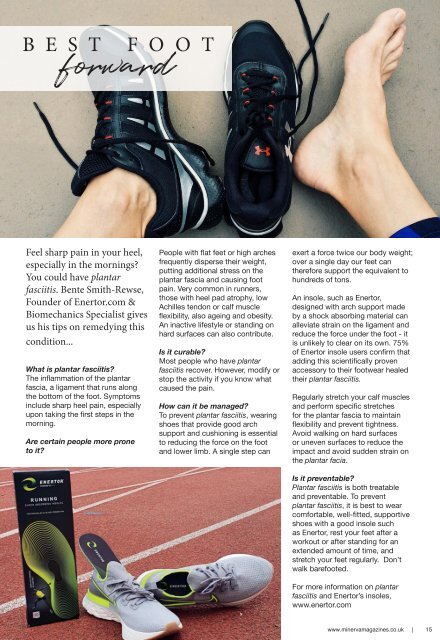Leamington and Warwick Living May - Jun 2024
Create successful ePaper yourself
Turn your PDF publications into a flip-book with our unique Google optimized e-Paper software.
B E S T F O O T<br />
forward<br />
Feel sharp pain in your heel,<br />
especially in the mornings?<br />
You could have plantar<br />
fasciitis. Bente Smith-Rewse,<br />
Founder of Enertor.com &<br />
Biomechanics Specialist gives<br />
us his tips on remedying this<br />
condition...<br />
What is plantar fasciitis?<br />
The inflammation of the plantar<br />
fascia, a ligament that runs along<br />
the bottom of the foot. Symptoms<br />
include sharp heel pain, especially<br />
upon taking the first steps in the<br />
morning.<br />
Are certain people more prone<br />
to it?<br />
People with flat feet or high arches<br />
frequently disperse their weight,<br />
putting additional stress on the<br />
plantar fascia <strong>and</strong> causing foot<br />
pain. Very common in runners,<br />
those with heel pad atrophy, low<br />
Achilles tendon or calf muscle<br />
flexibility, also ageing <strong>and</strong> obesity.<br />
An inactive lifestyle or st<strong>and</strong>ing on<br />
hard surfaces can also contribute.<br />
Is it curable?<br />
Most people who have plantar<br />
fasciitis recover. However, modify or<br />
stop the activity if you know what<br />
caused the pain.<br />
How can it be managed?<br />
To prevent plantar fasciitis, wearing<br />
shoes that provide good arch<br />
support <strong>and</strong> cushioning is essential<br />
to reducing the force on the foot<br />
<strong>and</strong> lower limb. A single step can<br />
exert a force twice our body weight;<br />
over a single day our feet can<br />
therefore support the equivalent to<br />
hundreds of tons.<br />
An insole, such as Enertor,<br />
designed with arch support made<br />
by a shock absorbing material can<br />
alleviate strain on the ligament <strong>and</strong><br />
reduce the force under the foot - it<br />
is unlikely to clear on its own. 75%<br />
of Enertor insole users confirm that<br />
adding this scientifically proven<br />
accessory to their footwear healed<br />
their plantar fasciitis.<br />
Regularly stretch your calf muscles<br />
<strong>and</strong> perform specific stretches<br />
for the plantar fascia to maintain<br />
flexibility <strong>and</strong> prevent tightness.<br />
Avoid walking on hard surfaces<br />
or uneven surfaces to reduce the<br />
impact <strong>and</strong> avoid sudden strain on<br />
the plantar facia.<br />
Is it preventable?<br />
Plantar fasciitis is both treatable<br />
<strong>and</strong> preventable. To prevent<br />
plantar fasciitis, it is best to wear<br />
comfortable, well-fitted, supportive<br />
shoes with a good insole such<br />
as Enertor, rest your feet after a<br />
workout or after st<strong>and</strong>ing for an<br />
extended amount of time, <strong>and</strong><br />
stretch your feet regularly. Don’t<br />
walk barefooted.<br />
For more information on plantar<br />
fasciitis <strong>and</strong> Enertor’s insoles,<br />
www.enertor.com<br />
www.minervamagazines.co.uk | 15


















